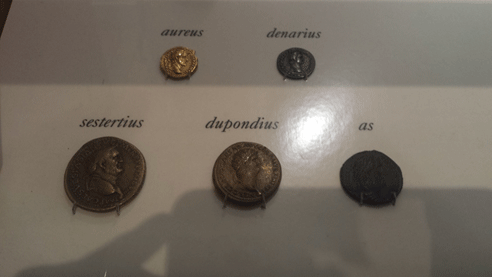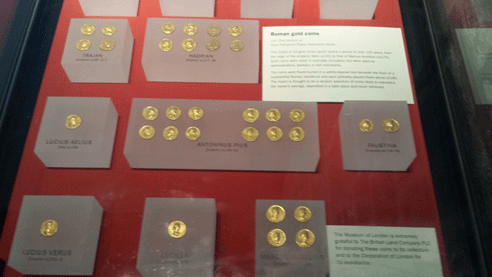Because the prime minister is engaged in his high-stakes negotiations over whether Britain should leave the European Union, I thought I’d put it in a more ancient context.
I’ve made it a personal goal to see something new in London every weekend. That keeps me from spending all my time reading books (a worthy pursuit) or eating biscuits. So far I’ve been to the Tate, the British Museum, seen The Book of Mormon, sampled many a whisky, watched a Christmas panto and been to the IMAX at Waterloo.
Last weekend, at the recommendation of a cabbie, I went to the Museum of London near the London Wall. London, like Rome and Paris, is one of those modern living cities that’s also thousands of years old. From the geology to the anthropology, I find it all fascinating. And then there’s the money. See the coins below.


The shiny gold coins, in the bottom picture, were recovered from a home. Someone had an eye for bright things. It’s a portfolio of the Roman gold coins used early in the first two centuries of the Common Era (or AD as we used to say).
The top picture shows the most common Roman coins by denomination and metal value. It was accompanied by a nice caption which read:
The stability of the 1st and 2nd centuries is reflected in the quality of Roman coinage. By the third century, rising inflation meant that loose change was scarce. Here was a ready market for the forger.
There’s a lot going on there for a tiny passage of text. Let’s unpack it! First, there is a relationship between sound money and a stable political order. Rome thrived (assuming you were white, male and free) when the money was stable. The political decline and the monetary decline were likewise companions.
Second, loose change became scarce when inflation turned up. This is Gresham’s law action, where bad money tends to drive out good. People hoard the good stuff and get rid of the stuff that’s declining in value. It explains, for example, why you’d take your cash out of a bank charging you interest on savings.
Also, Gresham’s law explains why banks keep gold in vaults. It’s too valuable to use as a medium of exchange. But it has high utility as a store of value (or at least as an instrument whose price in another currency will rise with the rate of inflation).
Who is the forger today? The forger is the central bank with its quantitative easing. Or, if things keep trending, the central bank with its “digital legal tender”. Unfortunately there is nowhere to flee from that kind of forgery, unless it’s into tangible goods the state can’t “delete”.
Category: Economics

